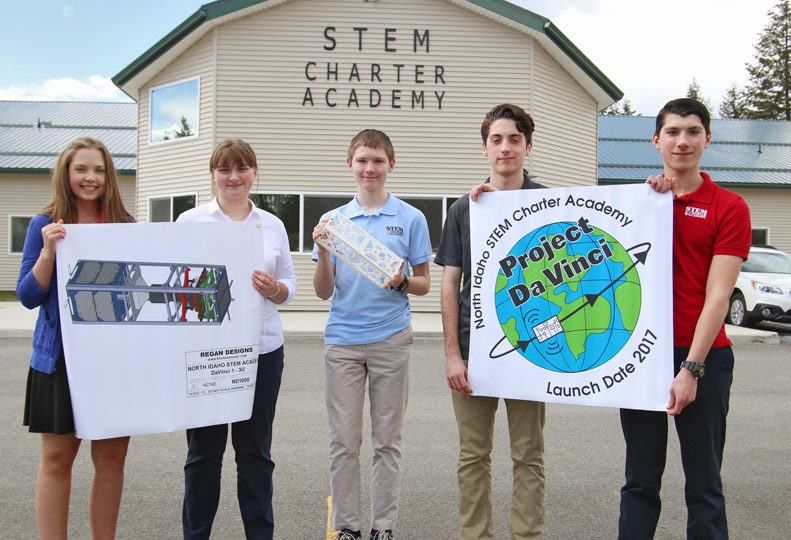
Home » Space studies blast off at North Idaho STEM Charter Academy
Space studies blast off at North Idaho STEM Charter Academy
North Idaho STEM Academy to send own satellite into orbit

April 13, 2017
Students at North Idaho STEM Charter Academy, in Rathdrum, have started up their own space program, dubbed Project DaVinci, and they hope to inspire excitement among younger people around the world about science, technology, engineering, and math—and space.
The Rathdrum-based charter school is the only high school among 20 recipients of NASA grants awarded last year to design satellites to be launched into orbit.
The tagline for Project DaVinci’s mission is “Lighting up minds around the world.”
To that end, Jessica Millard, a junior and one of five project leads, says, “Our goal is to get at least one classroom from every country around the world to participate and at least one classroom from every state.”
Classes that want to participate can register at projectdavincicubesat.org.
The student-led Project DaVinci team will be in some lofty company.
Other selected teams represent elite higher education schools and research labs, such as Massachusetts Institute of Technology, U.S. Naval Academy, California Polytechnic State University, and NASA’s own Jet Propulsion Lab.
The satellites are scheduled to be launched from New Zealand in November.
Though the value of the NASA grant is estimated at $5 million, the Project DaVinci team will be responsible for raising $250,000 toward the launch.
Students last month raised nearly half of that amount at a fundraiser at the Coeur d’Alene Resort in which the largest donation was $25,000.
Millard says the Project DaVinci team likely will launch a Kickstarter campaign on social media in May.
The students also hope to raise enough funds to travel to New Zealand to view the launch.
Teams design the satellites, called nanosatellites or CubeSats, to fit within 4-inch cube frames.
The DaVinci Project satellite will include three cubes attached in line.
It will be equipped with a specialized camera and radio communications equipment, among other space gear.
Sophomore project lead Justin Kugler says each project lead heads assigned aspects of the project, although they’re all currently working together on fundraising.
“My official role is to go over the design and make sure parts get purchased as needed and make sure the outsourcing to the company that’s building the satellite goes as planned,” Kugler says.
Some historic firsts that the students are planning start with the first satellite-to-satellite internet connection with the GlobalStar network.
Joe Broder, a junior project lead, says, “Using that connection, we’re going to allow people to post from social media in space.” Social media messages relayed through the satellite will be tagged in space.
Jessica Millard adds, “So far, we have details confirmed that we can use Twitter, and I believe we’re now confirmed that we can use Facebook, too—in space.”
Using the connection, the satellite will be the conduit for the first bitcoin transaction though space, she adds.
Broder says that while students are designing the satellite with the help of mentors, the satellite assembly is being contracted to Scotland-based Clyde Space, which has specialized labs.
“We don’t have space-grade clean rooms yet,” he says.
The Project DaVinci team is designing some interactive features into the satellite’s systems.
“Were going to try to build a feature on our website where you’ll be able to get a view from our satellite so you’ll feel like you’re actually there controlling the satellite,” Broder says. “It’s a way for people to get engaged.”
Millard adds that interactive features “will give people a personal connection with space again.”
Project lead Paige Pence, a junior, continues, “The younger generation hasn’t been able to see Apollo launches for the space shuttle. This will be something to get them excited about space.”
The satellite will have some ability to communicate via radio signals, and the Project DaVinci team hopes to share messages with schools around the world via Morse code.
The Project DaVinci satellite will carry a digital time capsule, and students are collecting digital media and messages from around the world to include in it.
Early in the project, they caught the attention of recording artist Taylor Swift, who has sent music and a message, and has pledged support.
Major project sponsors also can have messages engraved and digitally recorded and delivered into space.
Pence says the satellites will be contained in individual pods aboard an Electron rocket, which was developed by Los Angeles-based Rocket Lab.
“It will be one of Rocket Labs’ first launches with this rocket,” she says. “Once the rocket is at a certain point in space, each of the pods will be deployed.”
Pence says the project participants are learning some real-world lessons about putting a complex project together, including asking businesses and sponsors for funding and in-kind support.
Adds Broder, “We learned pretty fast how things happen and how important testing is. It’s not just as easy as, ‘We built a satellite. Please put it on our rocket.’”
Project DaVinci technically is an extracurricular activity. However, student participants have been sharing what they’ve learned with other classrooms, even developing lesson plans to present to primary grades.
Millard says, “Our most accurate measure of our project’s success is if we have kids coming up to us and telling us they were inspired by our project or they had decided what career they were going to do because of our project.”
She says the project has inspired her to pursue a career in aerospace. She had been considering a career in biology, but recently changed her mind.
“Satellites are cool,” Millard says.
Latest News Up Close Education & Talent North Idaho
Related Articles
Related Products




